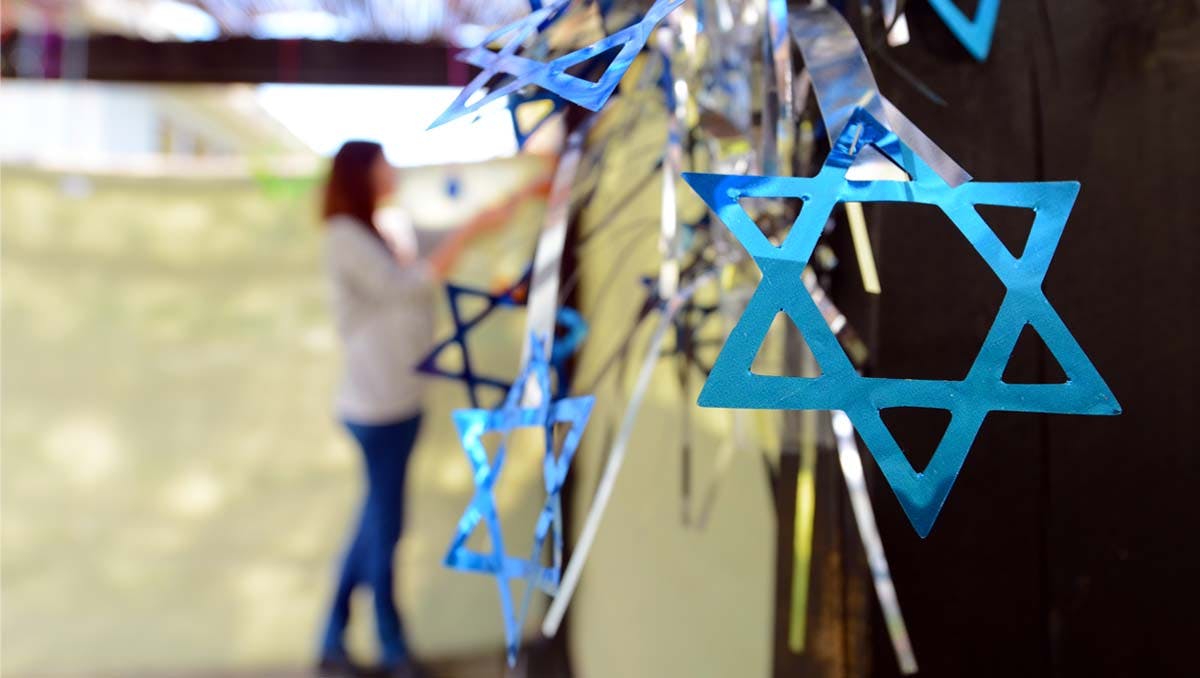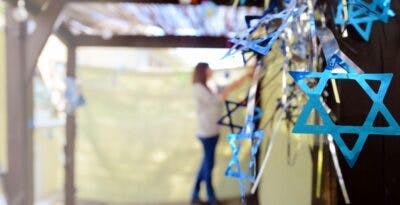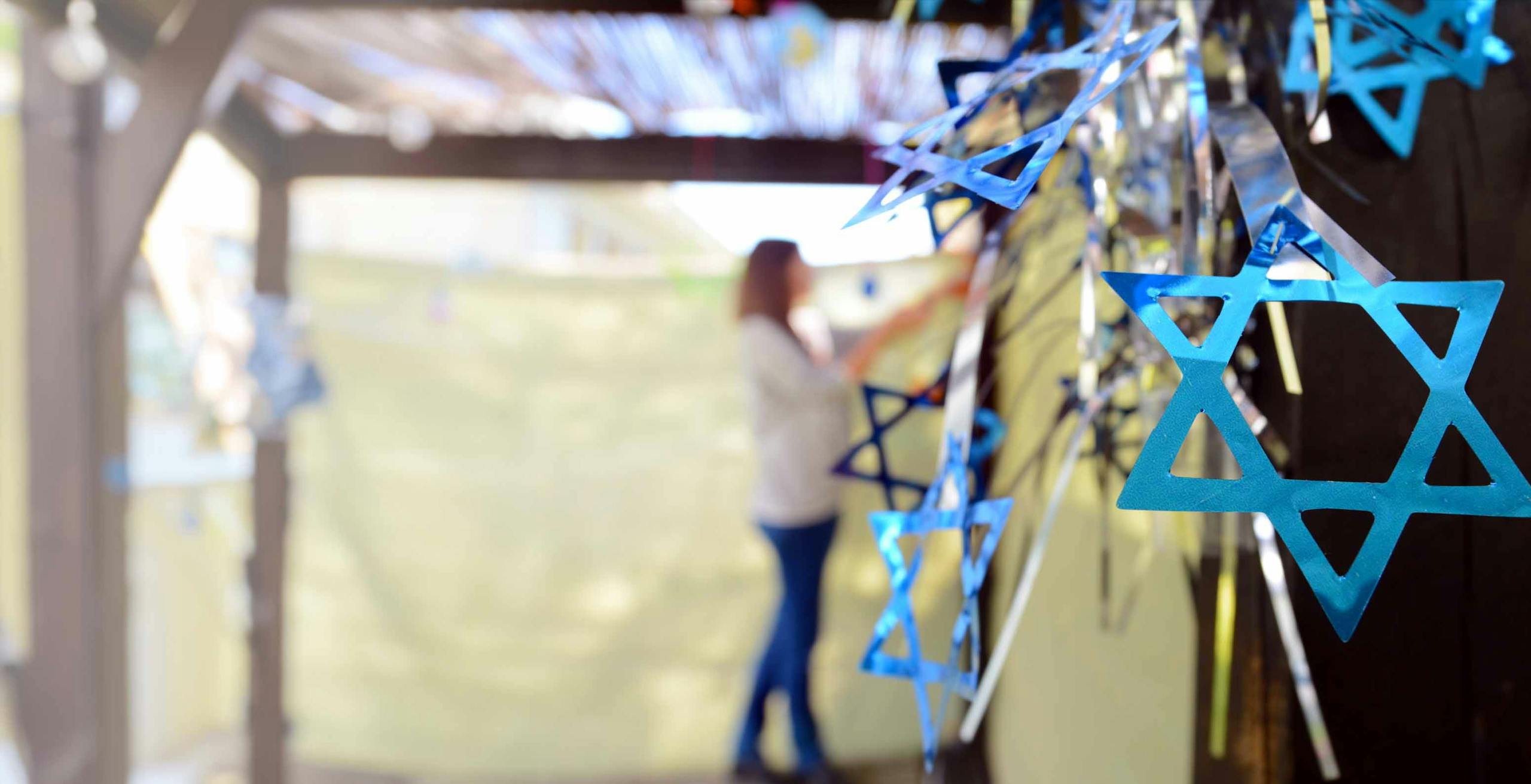
Hidden Hope in Sukkot
Our journey in the desert isn’t over yet.
by Laura Costea | September 28 2023
Sukkot is a bit of a mystery. Why do we need a holiday based on building a tent and eating (and sometimes even sleeping) outside?
For someone like me who’s trying to reclaim a Jewish heritage later in life, building the sukkah is a bit of a mystery too. Looking online only complicates matters. You can order anything from a $3,000 fancy sukkah to a $200 personal, pop-up sukkah!
So my family will do what we’ve done in prior years: we will use what we have on hand, which is probably how the holiday began anyhow. There’s something beautiful about the imperfection of a homemade sukkah. Maybe it’s the vulnerability of it that makes it beautiful.
Anyone who’s tried camping can relate to this feeling of vulnerability. Getting out in the elements away from our normal comforts forces us to let go of whatever measure of control we may have over our environment. Perhaps this “letting go” is partly what God had in mind when He made Israel dwell in the desert with Him long ago.
Just like all our holidays, there is still a reason to celebrate Sukkot today. The Lord established the Feast of Tabernacles as a lasting ordinance (Leviticus 23:41). So that means the idea that we would tabernacle with Him isn’t over yet! Jewish believers in Jesus consider the elements of Sukkot to point very tangibly to the Messiah and to our future hope of dwelling with him forever. Here are four reasons why.
The Dwelling Place
When Moses gave us the words that would teach us how to live in harmony with God’s presence and with one another, he included these instructions about the Feast of Tabernacles:
On the fifteenth day of the seventh month, when you have gathered in the produce of the land, you shall celebrate the feast of the Lord seven days.… All native Israelites shall dwell in booths, that your generations may know that I made the people of Israel dwell in booths when I brought them out of the land of Egypt: I am the Lord your God. (Leviticus 23:39, 42–43)
God promised to bring ancient Israel into the beautiful land, and He did. Why then would He draw them outside again year after year? For the same reason that we celebrate Passover every spring: to remember. We remember that the Lord called us out of Egypt, dwelt with us, and protected us then. And as we practice the holidays, we do so believing that our journey with Him isn’t over yet.
The Feast of Tabernacles should remind us that God wants to be with us. He guides us to unknown places and will lead us to the promised land.
We practice the holidays believing that our journey with God isn’t over yet.
For Jewish believers in Jesus, this idea takes on a new meaning. The surprising, wonderful, and admittedly a bit confusing thing that Jesus’ first Jewish followers discovered was that in the Messiah, God Himself had appeared in our midst. When we celebrate Sukkot, we step outside our comfort and into a more frail dwelling, and we believe that when Messiah came, He embodied this very idea. As one of Jesus’ disciples put it: “[God] became flesh and tabernacled among us” (John 1:14 TLV, emphasis added).
Setting aside the difficult question of how God could become a person, the idea of God being both the creator and king of the universe, and yet somehow interested in drawing near to us in surprising and physically present ways, is straight out of Torah. From Abraham to Moses, story after story shows God has no qualms about entering His world and being with us: “I will walk among you and will be your God, and you shall be my people” (Leviticus 26:12, emphasis added).
So, Messianic Jews believe that in the person of Jesus, God put on a frail frame to live among us.
Living Water
Agricultural Israel, living before modern conveniences like running water, saw Sukkot as a time to pray earnestly for God’s provision. No rain would mean no crops; no crops would mean no food.
And so, Sukkot was a time both to remember how God had been faithful to us in the desert and to ask Him to continue being faithful in the year to come. These prayers reached their climax on the last day of Sukkot, “The Day of the Great Hosanna.”
To show our hope for rain for Israel’s crops, the High Priest poured water from the pool of Siloam into a basin at the foot of the altar. That water was also a symbol to our people of God’s Spirit.1
We may not daily feel an urgent need for rain like ancient Israel did, but we can all relate to feeling spiritually or emotionally thirsty. When Jesus celebrated Sukkot, he claimed to be the answer to our inner thirst.
On the last day of the feast, the great day, Jesus stood up and cried out, “If anyone thirsts, let him come to me and drink. Whoever believes in me, as the Scripture has said, ‘Out of his heart will flow rivers of living water.’ Now this he said about the Spirit, whom those who believed in him were to receive, for as yet the Spirit had not been given, because Jesus was not yet glorified. (John 7:37–39)
At Sukkot, we always prayed for water, but it was the kind that came and went and only met an immediate, physical need, and it required prayers again the next year. Jesus, echoing the prophets (Zechariah 14:8; Ezekiel 47) brought a promise of a well that would never run dry: the presence of God’s Spirit welling up within us.
The Harvest
Sukkot came at a time each year when the fields had just been harvested. The prayers and praises we offer to God at this time remind us that He’s provided everything we have! And He’s providing for you too. Our dependence on Him doesn’t end no matter how far removed from the desert we are
Today, we decorate our sukkot (the name of the holiday and also the plural form of the word “sukkah”) with fruit or other food items as a way to remember and thank God for His provision.
Our dependence on God doesn’t end no matter how far from the desert we are.
Jesus also promised a fruitful life for all who put their trust in him: “I am the vine; you are the branches. Whoever abides in me and I in him, he it is that bears much fruit, for apart from me you can do nothing” (John 15:5, emphasis added).
The Celebration
Sukkot is often called “the Season of our Joy,” and no wonder. Our ancestors celebrated with the understanding that God had led us through the desert and wanted to lead us still. All people—from the oldest to the youngest, from the weakest to the strongest, united together under one sky, dwelling with one purpose–looking forward to one great promise.
Sukkot was one of the three pilgrimage festivals (when Jewish men were required to present themselves at Jerusalem). Traditionally, Sukkot means not just being with the Lord, but praising Him with everything we have by singing the psalms, waving the lulav and holding the etrog, and even dancing as we remember how our ancestors danced in the desert with God.
The imagery of waving branches before the Lord appears in the New Testament as well, when Jesus rode into Jerusalem. A crowd of Jewish people took “branches of palm trees and went out to meet him, crying out, ‘Hosanna!’” (John 12:13, emphasis added; Hosanna was the same word traditionally used at Sukkot in the prayers for living water).
Sukkot in God’s Forever Kingdom
The above four elements of Sukkot can also be found in biblical writings about the new kingdom. Let’s unpack that now.
- The dwelling place: One of Jesus’ earliest Jewish disciples saw a vision of the new kingdom and wrote this using the same word we use for the Feast of Tabernacles: “Behold, the dwelling of God is among men, and He shall tabernacle among them. They shall be His people, and God Himself shall be among them and be their God” (Revelation 21:3 TLV, emphasis added).
Not only will He dwell with us, but He will actually be our dwelling place: “I saw no temple in the city, for its temple is the Lord God the Almighty and the Lamb” (Revelation 21:22).
- Living water: John’s vision of the new kingdom also included a picture of living water. He wrote, “The river of the water of life, bright as crystal, flowing from the throne of God and of the Lamb through the middle of the street of the city” (Revelation 22:1–2).
This sounds strikingly reminiscent of Zechariah’s prophecy: “On that day living waters shall flow out from Jerusalem, half of them to the eastern sea and half of them to the western sea. It shall continue in summer as in winter” (14:8, emphasis added). Messianic Jews believe that “that day” will come when Jesus returns to reign on the earth.
- The harvest: Even at Sukkot, life can be so changeable; we may experience a bounty of food one year and then other, leaner years. Yet John’s vision of the future kingdom included an everlasting fruit that God will provide for us. “On either side of the river, [was] the tree of life with its twelve kinds of fruit, yielding its fruit each month. The leaves of the tree were for the healing of the nations” (Revelation 22:2). The tree of life in the new kingdom will bear fruit for all who dwell there.
- The celebration: Zechariah also foretold a future unity in the way we’ll celebrate: “Then the survivors from all the nations … will go up year after year to worship the King, the Lord Almighty, and to celebrate the Feast of Tabernacles” (Zechariah 14:16 NIV, emphasis added).
One of the best gifts of the Sukkot to come is that the Jewish people will be able to practice the hospitality we so highly value! We will no longer be trying to survive and protect ourselves from the nations around us, but rather, the nations will be coming in peace to worship with us.
Everlasting Security
At Sukkot, Passover, and other times during the year, we may pray the Psalms. Why? Aren’t we hoping—and choosing to believe—that God is as faithful today as He was then? That we can trust Him like the psalmists did?
We’ve never seen the dwelling where he’s leading us, but we do know it’s worth hoping for.
There is a lot we don’t know about the hereafter, but just because we don’t know everything doesn’t mean we can’t know some things. We can invest as much time and money as we want into our homes and our physical bodies, yet we know that all our frail frames will fail us eventually. And we know that if God could be trusted to lead Abraham out to a new land, if He could be trusted to protect our ancestors in the desert, then He can be trusted to construct an eternal dwelling place for us too. His presence is sufficient—it always has been.
Perhaps that’s what it means to be a Messianic Jew: to be okay with mystery and hope walking hand in hand and to know that Jesus intersects them both. We’ve never seen the dwelling where he’s leading us, but we do know it’s worth hoping for.
We also know that our future hope comes with the peace that we’ve long awaited. In the city where the Lord is our temple, there will be no war, no fear, only complete safety: “Its gates will never be shut by day—and there will be no night there” (Revelation 21:25).
The Feast of Tabernacles reminds us to look back, but it also invites us to look forward to a future more secure than anything we’ve ever known on earth. God grants this security to all who would let Him be their dwelling place.
Endnotes
1 Janie-Sue Wertheim and Kathy Shapiro, Walk with Yeshua Through the Jewish Year (San Francisco: Jews for Jesus, 2015).

